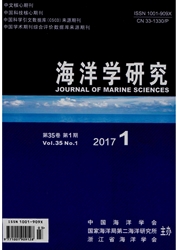

 中文摘要:
中文摘要:
阐述了一种基于表面生成的多波束数据处理方法——CuBE(Combined Uncertaintv and Bathymetry Estimator)算法,用该方法可以对观测区域网格节点“真实”水深及相关误差进行估计。与从测量水深中选择出“最佳”数据的手工交互方式的多波束数据编辑手段不同,CUBE算法具有很强的抗差性和较高的效率,适合于实时多波束数据处理。对南海某测区多波束数据处理结果表明,在没有人工干预的情况下,利用CUBE算法去噪生成的海底DTM图与手工编辑生成的相当吻合。CUBE算法和手工编辑方法综合对比得出,CUBE算法能够很好地保留水深地形细节,在计算效率、误差评估、实时处理等方面比手工编辑方法具有较大的优势。
 英文摘要:
英文摘要:
Multi-beam Echo-sounder (MBES) is currently the best device of full coverage seabed scanning to collect high density depth data of high accuracy for reliable seabed topography. The main problem is the processing of the huge amount of data. At present, noise removal of the MBES data is based on manual intercalibration of single sounding line, that is, to edit the data manually section by section, which is not only time-consuming but also liable to subjective consciousness. Automatic data processing is urgently needed for the new generation of MBES. With the assumption of successive variation of seabed topography, scientists at home and abroad have made some results in the automatic detection of MBES data abnormalities, which fastened the processing of the data to some extent, but led to such problems as robustness, poor reliability and so on and the sounding data need to be marked with "truth" or "untruth" in a small area with low efficiency. Thus CUBE algorithm is introduced here which is able to estimate the true depth of the grid points of the survey area. CUBE algorithm is an estimation of the depth and related uncertainty for the grid points of the survey area based on MBES data. With the increasing of the sounding data the estimations were updated continuously. In order to increase the reliability of the estimation, median filtering was implemented to select sounding data, and then Kalman filtering method was used to generate the depth and related uncertainty of the node in the survey area. Kalman filtering is a dynamic tracing process, as more and more data are assimilated, the estimation of depths become more and more accurate and the uncertainties become smaller and smaller. When a number of potential depth estimations occur at one node, some metrics, such as the number of depth soundings used to generate the estimation, or closeness to neighbor depths, are used to choose the most likely depth value. Since the core of the algorithm is the estimation of the depth and uncertainty at the node,
 同期刊论文项目
同期刊论文项目
 同项目期刊论文
同项目期刊论文
 期刊信息
期刊信息
